| Listing 1 - 10 of 22 | << page >> |
Sort by
|
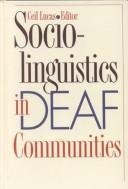
ISBN: 156368036X 9781563683459 Year: 1996 Publisher: Washington, D.C. Gallaudet University Press
Abstract | Keywords | Export | Availability | Bookmark
 Loading...
Loading...Choose an application
- Reference Manager
- EndNote
- RefWorks (Direct export to RefWorks)
Deaf --- Sociolinguistics --- #KVHA:Taalkunde; Gebarentaal --- #KVHA:Sociolinguïstiek; Gebarentaal --- Sign language --- Gesture language --- Language and languages --- Gesture --- Signs and symbols --- Language and society --- Society and language --- Sociology of language --- Language and culture --- Linguistics --- Sociology --- Integrational linguistics (Oxford school) --- Speech-reading --- Speechreading --- Communication --- Means of communication --- Social aspects --- Sociological aspects --- Education --- Speech
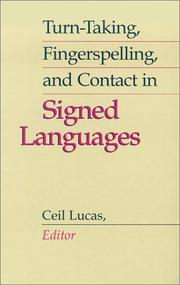
ISBN: 1563681285 Year: 2002 Publisher: Washington Gallaudet university press
Abstract | Keywords | Export | Availability | Bookmark
 Loading...
Loading...Choose an application
- Reference Manager
- EndNote
- RefWorks (Direct export to RefWorks)
Bilingualism. --- Deaf --- Finger spelling. --- Sign language. --- Means of communication. --- #KVHA:Taalkunde; Gebarentaal --- Bilingualism --- Finger spelling --- Sign language --- Gesture language --- Language and languages --- Gesture --- Signs and symbols --- Dactylology --- Finger alphabet --- Fingerspelling --- Manual alphabet --- Manual speech --- Speech-reading --- Speechreading --- Communication --- Languages in contact --- Multilingualism --- Means of communication --- Education --- Speech
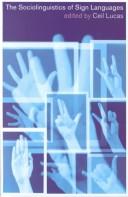
ISBN: 0521794749 0521791375 1107121493 0511174373 0511020260 0511154194 0511303602 0511612826 1280429984 0511046774 9780511020261 9780511154195 9780511046773 9780521791373 9780511612824 9781280429989 9786610429981 6610429987 9780521794749 9781107121492 9780511174377 9780511303609 Year: 2001 Publisher: Cambridge Cambridge University press
Abstract | Keywords | Export | Availability | Bookmark
 Loading...
Loading...Choose an application
- Reference Manager
- EndNote
- RefWorks (Direct export to RefWorks)
This is an accessible introduction to the major areas of sociolinguistics as they relate to sign languages and deaf communities. Clearly organised, it brings together a team of leading experts in sign linguistics to survey the field, and covers a wide range of topics including variation, multilingualism, bilingualism, language attitudes, discourse analysis, language policy and planning. The book examines how sign languages are distributed around the world; what occurs when they come in contact with spoken and written languages; and how signers use them in a variety of situations. Each chapter introduces the key issues in each area of inquiry and provides a comprehensive review of the literature. The book also includes suggestions for further reading and helpful exercises. The Sociolinguistics of Sign Languages will be welcomed by students in deaf studies, linguistics and interpreter training, as well as spoken language researchers, and researchers and teachers of sign language.
Deaf --- Sign language. --- Sociolinguistics. --- Means of communication. --- -Sign language --- Sociolinguistics --- #KVHB:Sociolinguistiek --- #KVHB:Gebarentaal --- Language and languages --- Language and society --- Society and language --- Sociology of language --- Language and culture --- Linguistics --- Sociology --- Integrational linguistics (Oxford school) --- Gesture language --- Gesture --- Signs and symbols --- Deaf-mutes --- Deaf people --- Deafness --- Hearing impaired --- Deafblind people --- Means of communication --- Social aspects --- Sociological aspects --- Sign language --- Patients --- #KVHA:Taalkunde --- #KVHA:Gebarentaal --- #KVHA:Sociolinguïstiek; Gebarentaal --- Speech-reading --- Speechreading --- Communication --- Education --- Speech --- Arts and Humanities --- Language & Linguistics
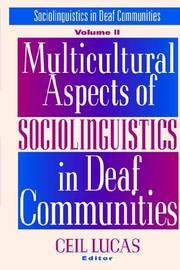
ISBN: 1563681080 Year: 1996 Publisher: Washington (D.C.) : Gallaudet university press,
Abstract | Keywords | Export | Availability | Bookmark
 Loading...
Loading...Choose an application
- Reference Manager
- EndNote
- RefWorks (Direct export to RefWorks)
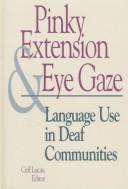
ISBN: 156368070X 9781563680700 Year: 1998 Publisher: Washington, D.C. Gallaudet University Press
Abstract | Keywords | Export | Availability | Bookmark
 Loading...
Loading...Choose an application
- Reference Manager
- EndNote
- RefWorks (Direct export to RefWorks)
Deaf --- Sign language --- Sociolinguistics --- #KVHA:Taalkunde; Gebarentaal --- #KVHA:Eye-tracking; Gebarentaal --- #KVHA:Eye gaze; Gebarentaal --- Language and languages --- Language and society --- Society and language --- Sociology of language --- Language and culture --- Linguistics --- Sociology --- Integrational linguistics (Oxford school) --- Gesture language --- Gesture --- Signs and symbols --- Deaf-mutes --- Deaf people --- Deafness --- Hearing impaired --- Deafblind people --- Speech-reading --- Speechreading --- Communication --- Means of communication --- Social life and customs --- Social aspects --- Sociological aspects --- Patients --- Education --- Speech

ISBN: 1563680467 9781563681080 Year: 1996 Publisher: Washington, DC Gallaudet University Press
Abstract | Keywords | Export | Availability | Bookmark
 Loading...
Loading...Choose an application
- Reference Manager
- EndNote
- RefWorks (Direct export to RefWorks)
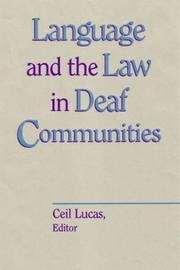
ISBN: 1563681439 1563683172 Year: 2003 Publisher: Washington Gallaudet university press
Abstract | Keywords | Export | Availability | Bookmark
 Loading...
Loading...Choose an application
- Reference Manager
- EndNote
- RefWorks (Direct export to RefWorks)
American Sign Language --- Deaf --- Forensic linguistics --- Law --- #KVHA:Doventolken --- #KVHA:Gebarentaal --- Linguistics --- Linguistics, Forensic --- Deaf-mutes --- Deaf people --- Deafness --- Hearing impaired --- Deafblind people --- AMESLAN (Sign language) --- ASL (Sign language) --- Sign language --- Legal status, laws, etc --- Language --- Jurisprudence --- Patients
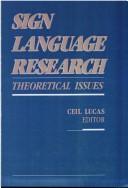
ISBN: 0930323580 Year: 1990 Publisher: Washington Gallaudet university press
Abstract | Keywords | Export | Availability | Bookmark
 Loading...
Loading...Choose an application
- Reference Manager
- EndNote
- RefWorks (Direct export to RefWorks)

ISBN: 1563682648 9781563682643 9781563680465 1563680467 9781563681080 1563681080 Year: 1996 Publisher: Washington, District of Columbia : Gallaudet University Press,
Abstract | Keywords | Export | Availability | Bookmark
 Loading...
Loading...Choose an application
- Reference Manager
- EndNote
- RefWorks (Direct export to RefWorks)
Deaf --- Sociolinguistics. --- Education. --- Deaf people
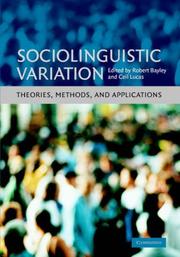
ISBN: 9780521871273 9780521691819 0521691818 9780511619496 9780511367601 0511367600 0511366388 9780511366383 0511619499 9786611146221 6611146229 0521871271 1281146226 9781281146229 0511367015 9780511367014 0511365756 9780511365751 0511573642 9780511573644 1107180287 9781107180284 Year: 2007 Publisher: Cambridge Cambridge university press
Abstract | Keywords | Export | Availability | Bookmark
 Loading...
Loading...Choose an application
- Reference Manager
- EndNote
- RefWorks (Direct export to RefWorks)
Why does human language vary from one person, or one group, to another? In what ways does it vary? How do linguists go about studying variation in, say, the sound system or the sentence structure of a particular language? Why is the study of language variation important outside the academic world, in say education, the law, employment or housing? This book provides an overview of these questions, bringing together a team of experts to survey key areas within the study of language variation and language change. Covering both the range of methods used to research variation in language, and the applications of such research to a variety of social contexts, it is essential reading for advanced students and researchers in sociolinguistics, communication, linguistic anthropology and applied linguistics.
Sociolinguistics --- Dialectology --- Language and languages --- Variation --- Sociolinguistics. --- Variation. --- Sociolinguïstiek --- Taalvarianten --- Taalverandering --- Sociolinguïstiek. --- Taalvarianten. --- Taalverandering. --- Language and society --- Society and language --- Sociology of language --- Language and culture --- Linguistics --- Sociology --- Integrational linguistics (Oxford school) --- Characterology of speech --- Language diversity --- Language subsystems --- Language variation --- Linguistic diversity --- Variation in language --- Social aspects --- Sociological aspects --- Arts and Humanities --- Language & Linguistics --- Variation linguistique --- Language and languages - Variation --- Sociolinguistique
| Listing 1 - 10 of 22 | << page >> |
Sort by
|

 Search
Search Feedback
Feedback About UniCat
About UniCat  Help
Help News
News